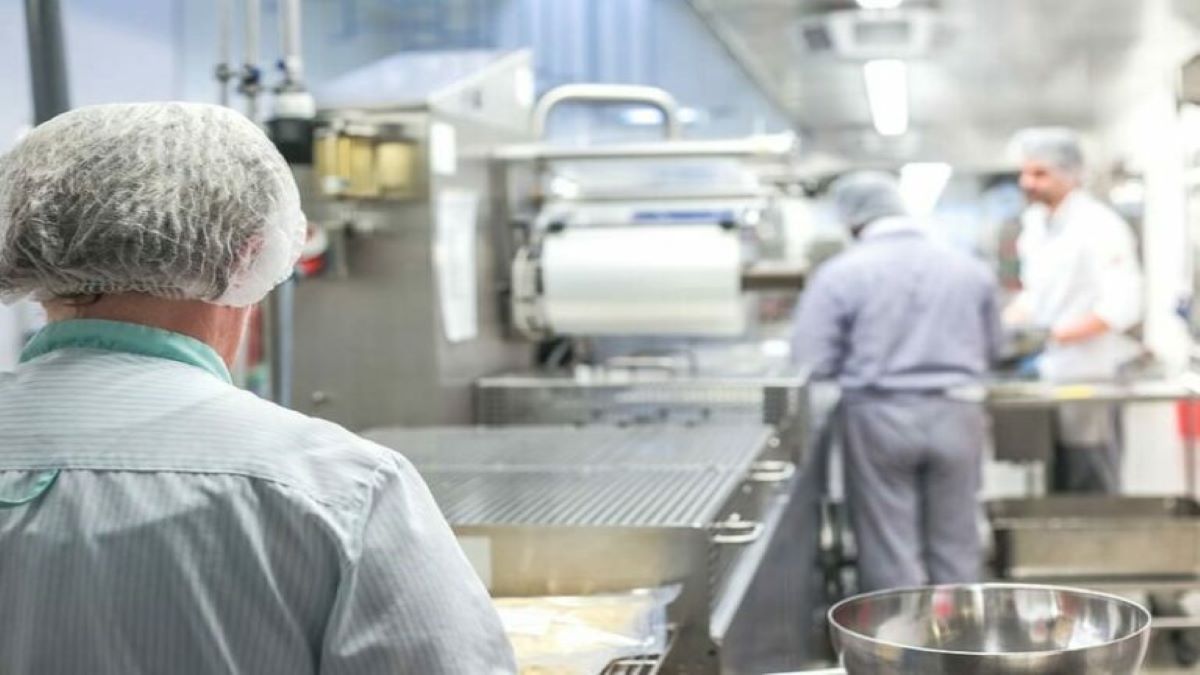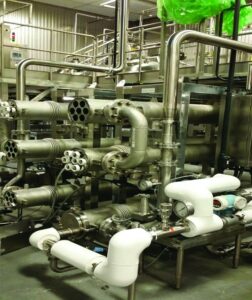
March 4, 2021
The thermal mechanisms that power a heat exchanger and the importance of selecting an appropriate heat transfer fluid
The use of heat exchangers throughout the food industry has revolutionized and improved a number of food processing methods. Without them, milk products would foul almost instantly, and the expiry date of pasta sauces would be shortened to only a few weeks. These are just a couple of examples of how heat exchangers can improve different elements in food production. Heat exchangers are used to perform a variety of functions including pasteurization, sterilization, ultrahigh temperature processing (UTH), and other food processing needs. They are frequently used to reduce or eliminate microbials, therefore making a food product aseptic which is safe for consumption and extending its shelf life. Several studies have shown that heat exchangers can also reduce the processing energy demand and depending on the application, can recover up to 50% of wasted heat. A heat exchanger is most commonly used to heat or cool liquid food products prior to filling, drying, concentrating or packaging. There are dozens of different types of heat exchangers that are all uniquely designed to suite a specific user’s needs.

Figure 1: HSR R Series heat exchanger that can run in reverse at the end of a batch to collect leftover, valuable products.
Source: flowcontrolnetwork.com
A heat exchanger is a device designed to transfer heat between two or more fluids (liquids, vapors or gases). Depending on the type of heat exchanger being used, this transfer could be gas to gas, liquid to gas, or liquid to liquid. If the heat transfer is happening between two liquids, it occurs through a solid separator to prevent the fluids from mixing. Other design characteristics that could impact the functionality of a heat exchanger includes construction, materials and components, heat transfer mechanism and flow configurations. These thermal regulating devices are frequently used in a number of different industries including wastewater management, refrigeration, petroleum refining and nuclear power. Heat exchangers that utilize a fluid to fluid energy transfer must also comply to strict regulations imposed by US Food and Drug administration (FDA) and NSF international regarding the type of thermal fluid used to ensure that there are no risks of contamination or harm to the consumer. On a basic level, all heat exchangers are engineered according to the general principles of thermodynamics but can be customized and specialized for different users and functions.
The thermal processes that are used by heat exchangers in the food industry can be broken down into two main heat transfer mechanisms known as conduction and convection. Conduction is the movement of heat between materials that are in direct contact with one another. This movement of heat is quantified by observing a change in the temperature of the two materials. Temperature is a measure of the average kinetic energy that the molecules that make up a specific material have. Materials that are warmer will exhibit more molecular motion (kinetic energy) and therefore display a higher temperature. When a warmer object comes into contact with a cooler object, a thermal energy transfer will occur between the two materials. The cooler object will then become more energized and its molecules will start to move faster. Meanwhile, the warmer material will start to decrease in temperature as it loses energy. This heat transfer will continue between the two materials until a thermal equilibrium has been achieved. Conduction occurs in a heat exchanger through the process of using a heat transfer fluid to moderate and balance the temperature of a liquid food product. Thermal regulating fluids, such as water or oil, generally have a low thermal conductivity which restricts their heat transferring abilities. Recent technology has favoured incorporating thermally conductive nanoparticles in a heat transfer fluid to increase its thermal conductivity and promote more efficient heat transfer. If the food product needs to be warmer, the thermal fluid can more easily be heated to a higher temperature, therefore helping both fluids reach an equilibrium.
Convection is the second method of heat transfer that a heat exchanger will use to regulate the temperature of a material. Convection defines the transfer of thermal energy through the movement of a fluid (liquid or gas) that occurs between areas of different temperatures. Most fluids expand when heated and will become less dense and start to rise. When a fluid is cooled, it will become denser and start to descend. For example, when the air in a room is heated, it will rise to the ceiling forcing cooler, more dense air to sink below it. This cool air is then heated and will rise, replacing the now cooler and more dense air located near the ceiling. This process creates what is known as a natural convection current. Convection can also occur through what is described as forced or assisted convection. This method of convection is employed when heated water is pumped through a pipe such as in a hydronic heating system.

Figure 2: Diagram of heat transfer occurring through conduction and convection
Conduction and convection describe the basic mechanics of any heat exchanger; however, it is crucial to consider some additional factors when selecting a heat exchanger to use for food processing. It is also important to think about what type of process the heat exchanger is preforming (pasteurization, sterilization or dehydration), the viscosity of the food or drink being processed and whether the food (liquid) contains small particles or pieces. It is also extremely important to select a safe and effective heat transfer fluid, preferably one that has been regulated as “food safe” by the FDA and/or NSF internationals standards. There are many fluids to choose from that are within both the FDA and NSF guidelines. Some specific fluids are classified as safe for “incidental food contact” such as brine, potassium formate (KF), polyalphaolephin (PAO) and highly refined, severely hydrogenated paraffinic white oils. Both PAO and white oils are heat transfer fluids that are often referred to as “hot oils”. When selecting a fluid, it is important to consider the requirements of the application and the thermal fluids specific temperature rating. These fluids are classified as H1 or HT1 “food grade” fluids and pose no risk to consumers if they were to accidentally encounter the food product. The majority of food grade fluids are non-toxic, non-hazardous and odorless which means that they require no special handling and are not considered a controlled substance under United States OSHA (Occupational Safety & Health Administration), Canadian WHMIS (Workplace Hazardous Materials Information System) or other work place regulations.

Figure 3: Canned beverage production line that would have experienced thermal regulation through a heat exchanger
It is also simply good practice for food production companies to use a HT1 heat exchanger fluid to ensure that there is a minimal chance of inflicting harm on the consumer. For example, a packaging line uses a non H1 heat transfer fluid to heat their adhesive that they use to seal frozen packaging. If a leak occurs within the heat exchanger, it could go undetected for a long period of time and potentially contaminate all the food products that are being packaged on this line. Any premium the company had paid for an “incidental food contact” fluid wouldn’t seem like much compared to the cost of replacing hundreds of thousands of units of contaminated packages. A challenge arises for food processing companies using HT1 fluids when the temperature requirements of the application exceed 600°F (316°C). These fluids do not have a high enough thermal stability to cope with these extreme temperatures and in this case, aromatic/synthetic or other high temperature fluids should be used as a replacement.
The widespread use of heat exchangers in the food processing industry has enabled manufacturing companies to produce food products that are safely and securely packaged, shipped and stored. They have also helped save these companies resources, energy and money. Many factors are considered when designing a heat exchanger that will effectively regulate the temperature of another fluid. One of the most important factors contributing to the overall success of a heat exchanger is the type of thermal fluid that is being used as a regulator. It is extremely important that the fluid be classified as a HT1 food grade fluid and deemed safe for incidental food contact by federal and global regulations. These food grade fluids drive the thermal processes of conduction and convection that power a heat exchanger as well as ensure safety to the consumer.
(n.d.). Retrieved from https://www.flowcontrolnetwork.com/industry-applications/food-beverage/article/15564211/heat-exchanger-equipment-for-food-processing
Ronquillo, R. (n.d.). Understanding Heat Exchangers. Retrieved from https://www.thomasnet.com/articles/process-equipment/understanding-heat-exchangers/
Maintaining heat transfer fluid in the food and beverage industry. (n.d.). Retrieved from https://www.automation.com/en-us/articles/2014-2/maintaining-heat-transfer-fluid-in-the-food-and-be
Garver, K. (2016, September 26). The Latest in Heat Exchangers for Food Processing. Retrieved from https://www.myprocessexpo.com/blog/industry-perspectives/the-latest-in-heat-exchangers-for-food-processing/
Webfoot. (2018, September 10). Specifying Heat Transfer Fluid For Food Processing Applications. Retrieved from https://www.radcoind.com/specifying-heat-transfer-fluid-for-food-processing-applications/
Author: Kallista Wilson | Junior Technical Writer | Thermtest